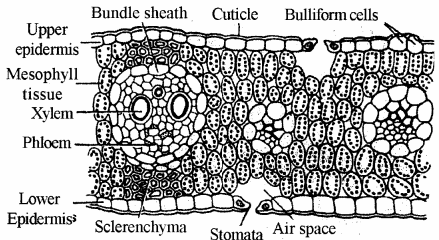Most of the monocotyledonous leaves are isobilateral but in some plants (Canna, Lilium, Musa, etc.), they are dorsiventral. The leaves usually show parallel venation. Each leaf is differentiated into leaf blade (lamina) and leaf sheath. In some cases, they may be petiolate. The monocotyledonous leaves also possess three distinct tissue systems –
- epidermis (epidermal tissue system),
- mesophyll (the ground tissue system) and
- vascular system
1. Epidermis:
- Each leaf has upper and lower epidermis made up of single layer of compactly arranged cells.
- The outer cells of epidermal cells are coated with thick or thin cuticle.
- In many grasses, the epidermal cells are impregnated with silica. The stomata are generally found on both the upper and lower epidermis.
- In some free floating hydrophytes and a few grasses, the stomata are found only on upper epidermis.
- All the epidermal cells are alike but in Poa pratensis, Ammophilla arenaria, Zea mays and many grasses, the epidermis is made up of two types of cells.
- Either upper or lower epidermis bears groups of large
- bubble-like cells in addition to ordinary epidermal cells. ‘
- These bigger cells are called bulliform cells or motor cells.
- These cells may be distributed irregularly or arranged in regular pattern.
These cells, by osmotic changes, help in the rolling and unrolling of leaves to regulate loss of water.
2. Mesophyll:
- The bulk of tissues lying between upper epidermis and lower epidermis (except vascular bundles) is called mesophyll.
- The mesophyll is either composed of similar types of cells (e.g., maize) or differentiated into palisade and spongy
Parenchyma.
- The monocot leaves are generally isobilateral and, therefore, the palisade is present on both upper and lower sides and the spongy parenchyma occupies the central position.
- All the cells of mesophyll contain chloroplasts and perform photosynthesis.
- These cells are separated by intercellular spaces which are interconnected and open into sub-stomatal chambers to maintain continuity with external atmosphere through stomata.
- A few monocot leaves are dorsiventral and possess palisade only below the upper epidermis (e.g., Lilium; Canna, Musa, etc.).
3. Vascular system:
- The monocot leaves are characterized by possessing parallel venation.
- Each vein comprises of single vascular bundle.
- Each bundle is conjoint, collateral and surrounded by distinct bundle sheath. ,
- In some cases, the bundle sheath is connected with upper and lower epidermis by groups of compact parenchymatous or sclerenchymatous cells called the bundle sheath extensions.
- The extensions are more pronounced in the mid-rib region.
- Each vascular bundle consists of xylem facing towards upper epidermis and phloem towards lower epidermis.
- In some cases, the phloem lies towards upper side and xylem towards lower side. The xylem and phloem elements are similar to those of dicotyledonous leaves.
